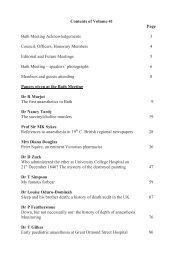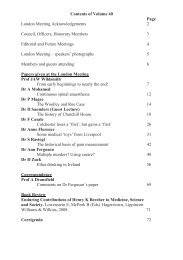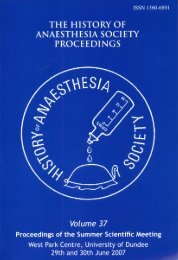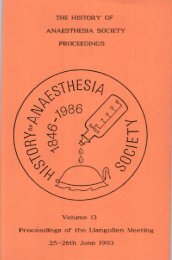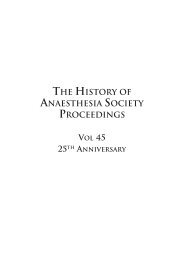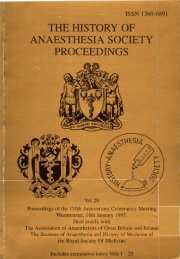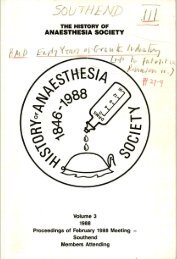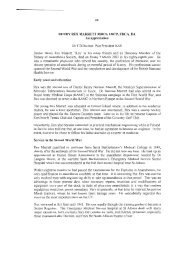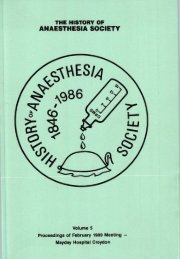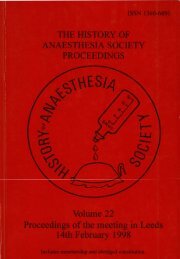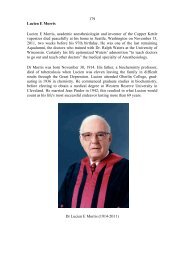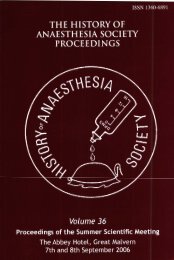Volume 9b - History of Anaesthesia Society
Volume 9b - History of Anaesthesia Society
Volume 9b - History of Anaesthesia Society
Create successful ePaper yourself
Turn your PDF publications into a flip-book with our unique Google optimized e-Paper software.
ack to old<br />
Fakirs and yogis used autohypotic anaesthesia<br />
and trance for their meditations. Eetween 2350 and 1350 B.C. we find<br />
hyposuggestive techniques in Persia and Greece, with rituals similar to<br />
group hypngsis today. Ekr's p3pyrus describs the we <strong>of</strong> hypnosis for<br />
analgesia. Specific hypotherapy was carried out in the Egyptian sleep<br />
hospitds <strong>of</strong> Isis and Csiris. Wing the sleep (incubation) the god3ess<br />
<strong>of</strong> Isis was irmgind to relieve ptients <strong>of</strong> their complaints. Sleep<br />
temples <strong>of</strong> Eqypthad a great influence later on similar constructiuns in<br />
Greece.<br />
Ihe pnelWlenhtic era <strong>of</strong> hyplosis<br />
In Homer's Odyssey XIX 457, Odysseus stops the bleeding <strong>of</strong> a wound<br />
through suggestion. Asklepios learned hypnosis from the Cenuurus<br />
Cheiron (Cheir - Gr. = hand).<br />
Achille3 knew the method too (the Iliad IV 219, XI R23). The Delphi<br />
Oracle used direct suggestive methods as well as herbs and drugs for<br />
induction.<br />
Ihe Aelldc era <strong>of</strong> hyplosia<br />
'Ihe Asklepion influence was <strong>of</strong> the greatest importance for hypnosis in<br />
the Hellenstic era. Patients came to the Asklepionan tarrplzs seeking<br />
relief from their maladies. The most famy <strong>of</strong> these temples w?re at<br />
Epidams, Kos, Knidos, Cmtana and Cyrene. Patients had first to<br />
perfonn washing rituals at natural wells. After these rituals the<br />
patients had to sleep outside the tenples for 3-5 nights. AFter this,<br />
they were admitted to the anteroom <strong>of</strong> the temple where they had to stay<br />
several days while praying and listening to the speeches <strong>of</strong> the priests.<br />
Later the patients could go into the holy part <strong>of</strong> the temple (Ahaton)<br />
which was attrilxlted with a magic force. The basis <strong>of</strong> t'lis kind <strong>of</strong><br />
hyplosis was the incubation = lying in a relaxed way. Suggestions were<br />
given before and during the trance period, either directly or by<br />
prescription <strong>of</strong> remedies.<br />
!Ifbe B y Z a I l era ~ <strong>of</strong> ~ hyplosis<br />
lhe Aesculapian form <strong>of</strong> therapy continued for many years, hut was<br />
changed by Galen <strong>of</strong> Pergmn (129-199 A.D.). me temple sleap method<br />
was changed by Galen to pre-sleepsuggestion-induction. me piltient<br />
received suggestions in the pre-sleep phase with the instn~ction to<br />
imagine a specific dream. lhis form <strong>of</strong> hypnosis therapy was ussd well<br />
into the 6th century.<br />
Wnile in Byzantine and Islamic states, mejicine reached a high level,<br />
the situation in mope was quite different. In the middle ages<br />
hypnotherapeutic techniques wsre used predominantly by mnastic orders<br />
who performed m y so-called 'wonder healingal with hypnosis. This<br />
nonastic practice supplanted Calenic medicine. One <strong>of</strong> the ,advances at<br />
this time was the use <strong>of</strong> an associative technique <strong>of</strong> suggestions to be<br />
able to distinguish between 'demons' ad real illnesses.



